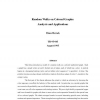Free Online Productivity Tools
i2Speak
i2Symbol
i2OCR
iTex2Img
iWeb2Print
iWeb2Shot
i2Type
iPdf2Split
iPdf2Merge
i2Bopomofo
i2Arabic
i2Style
i2Image
i2PDF
iLatex2Rtf
Sci2ools
ISTCS
1993
Springer
1993
Springer
Random Walks on Colored Graphs
This thesis introduces a model of a random walk on a colored undirected graph. Such a graph has a single vertex set and distinct sets of edges, each of which has a color. A particle begins at a designated starting vertex and an infinite color sequence ¡ is specified. At time ¢ the particle traverses an edge chosen uniformly at random from those edges of color ¡¤£ incident to the current vertex. The first part of this thesis addresses the extent to which an adversary, by choosing the color sequence, can affect the behavior of the random walk. In particular, we consider graphs that are covered with probability one on all infinite sequences, and study their expected cover time in the worst case over all color sequences and starting vertices. We prove tight doubly exponential upper and lower bounds for graphs with three or more colors, and exponential bounds for the special case of two-colored graphs. We obtain stronger bounds in several interesting special cases, including ra...
| Added | 10 Aug 2010 |
| Updated | 10 Aug 2010 |
| Type | Conference |
| Year | 1993 |
| Where | ISTCS |
| Authors | Anne Condon, Diane Hernek |
Comments (0)

